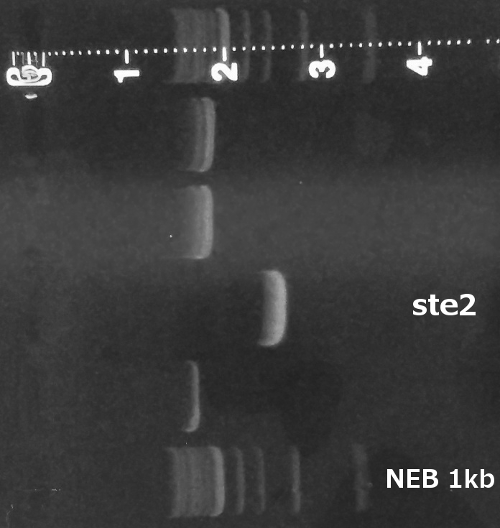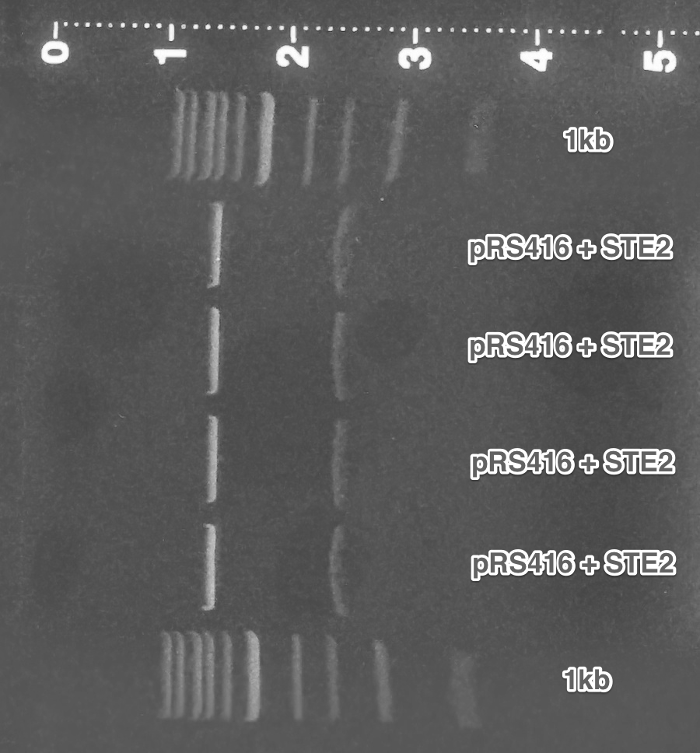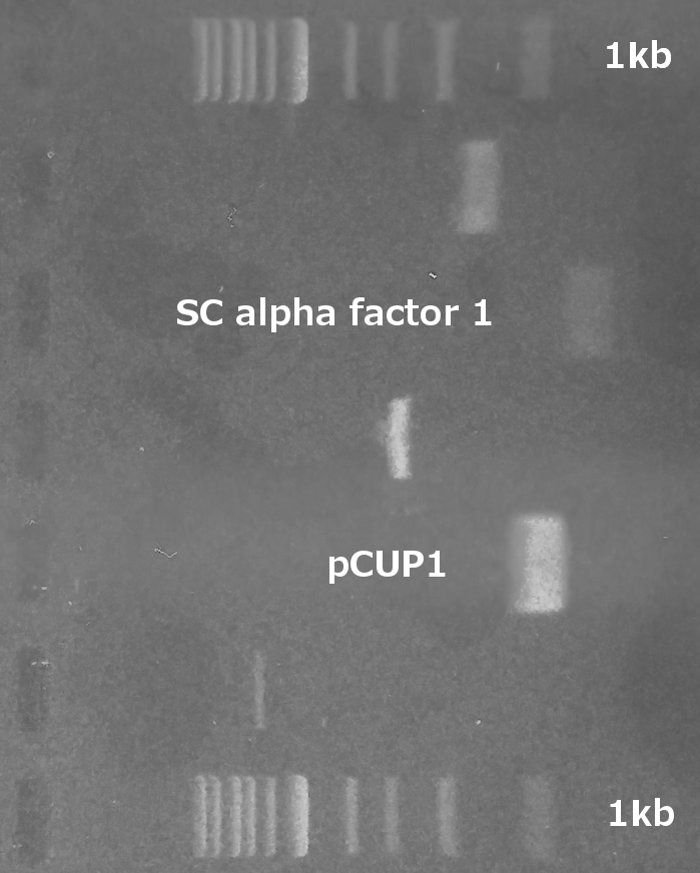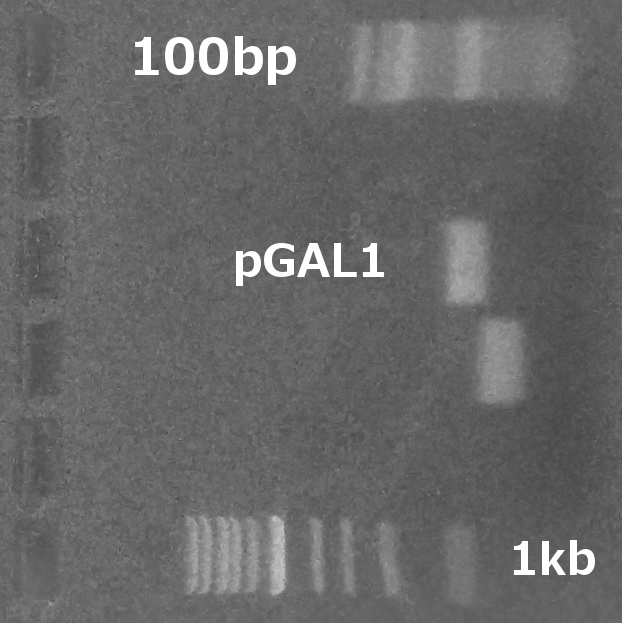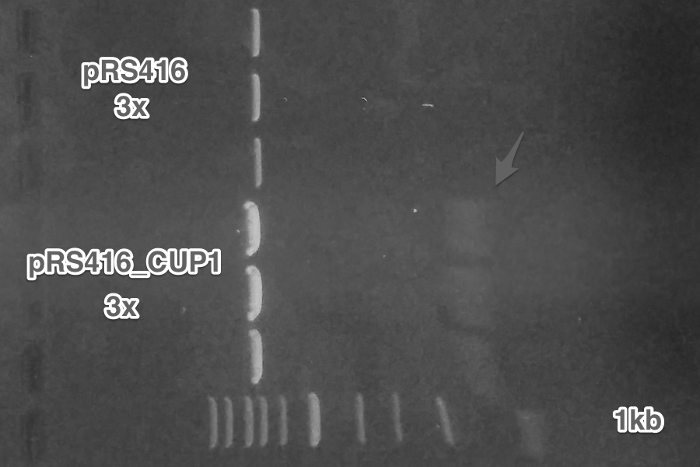Team:Czech Republic/Notebook
Notebook
Contents
May
Week 1 (4-10)
Module 1
Extraction of MATx genome - used strain 7283: MATx ura3-52 Gal+ (Genome extraction)
PCR amplification of all 6 parts of the final MATx intergration plasmid(PCR):
- MATalpha2 (template 7283 genome)
- CYC1v3 (template gBlock)
- pRS406 (template miniprep)
- STE12 w/ 3'UTR (template 7283 genome)
- pTv3 double promoter (template gBlock)
- MATalpha1 (template 7283 genome).
Gibson assembly (Gibson assembly)
- 2-round Gibson: first round with fragments 2-5, than MATalpha2 and MATalpha1 added
- 1-round Gibson: all parts together
Transformation of both Gibson assembly reactions into e. coli. Colony PCR showed unsuccessful Gibson assembly. (Transformation,Colony PCR,Gel electrophoresis)
Gibson assembly (Gibson assembly)
- reaction: parts 1, 2, 6
- reaction: parts 3, 4, 5
PCR amplification of fragments from Gibson reactions. Gel showed that Gibson 6,1,2 has the correct size. (PCR,Gel electrophoresis)
Gibson assembly 6,1,2+4+5 (Gibson assembly)
PCR amplification of fragments from Gibson reactions. Gel showed that Gibson 6,1,2+4+5 has the correct size. (PCR,Gel electrophoresis)
Gibson assembly 4,5,6,1,2 + 3 (vector). Gibson reaction was transformed into e-coli. Colony PCR showed unsuccessful Gibson assembly. (Gibson assembly,Transformation,Colony PCR,Gel electrophoresis)
Summary: We successfully extracted parts of MATx genome and connected 5 parts of synthetic MATx via Gibson assembly.
Module 2
PCR of the ste2 gene from the genome of Saccharomyces cerevisiae 7284 strain (Genome extraction, PCR, Gel electrophoresis).
Cloning of the amplified ste2 into pRSII416 vector (Restriction digest, Ligation, Transformation).
Verification of the pRSII416_ste2 construct (Miniprep, Restriction digest, Gel electrophoresis).
Summary: We successfully obtained ste2 gene from the yeast genome and cloned it into pRSII416 vector.
Module 3
Restriction testing of the pCT302 yeast display plasmid.
Auxotrophy testing of the yeast display yeast strain - EBY100.
Summary: We tested the EBY100 strain and pCT302 plasmid we recieved as a gift. Tests proved that we are ready for cloning of the streptavidin open reading frame.
Week 2 (11-17)
Module 1
Gibson assembly 4,5,6,1,2 + 3 (vector). Transformation into e. coli. 6 colonies obtained. Minipreps and restriction digest of all colonies. (Gibson assembly, Transformation, Miniprep, Restriction digest, Gel electrophoresis)
5 from 6 colonies that grow from Gibson assembly reaction show bands with correct sizes - MATX integration plasmid has been assembled successfully.
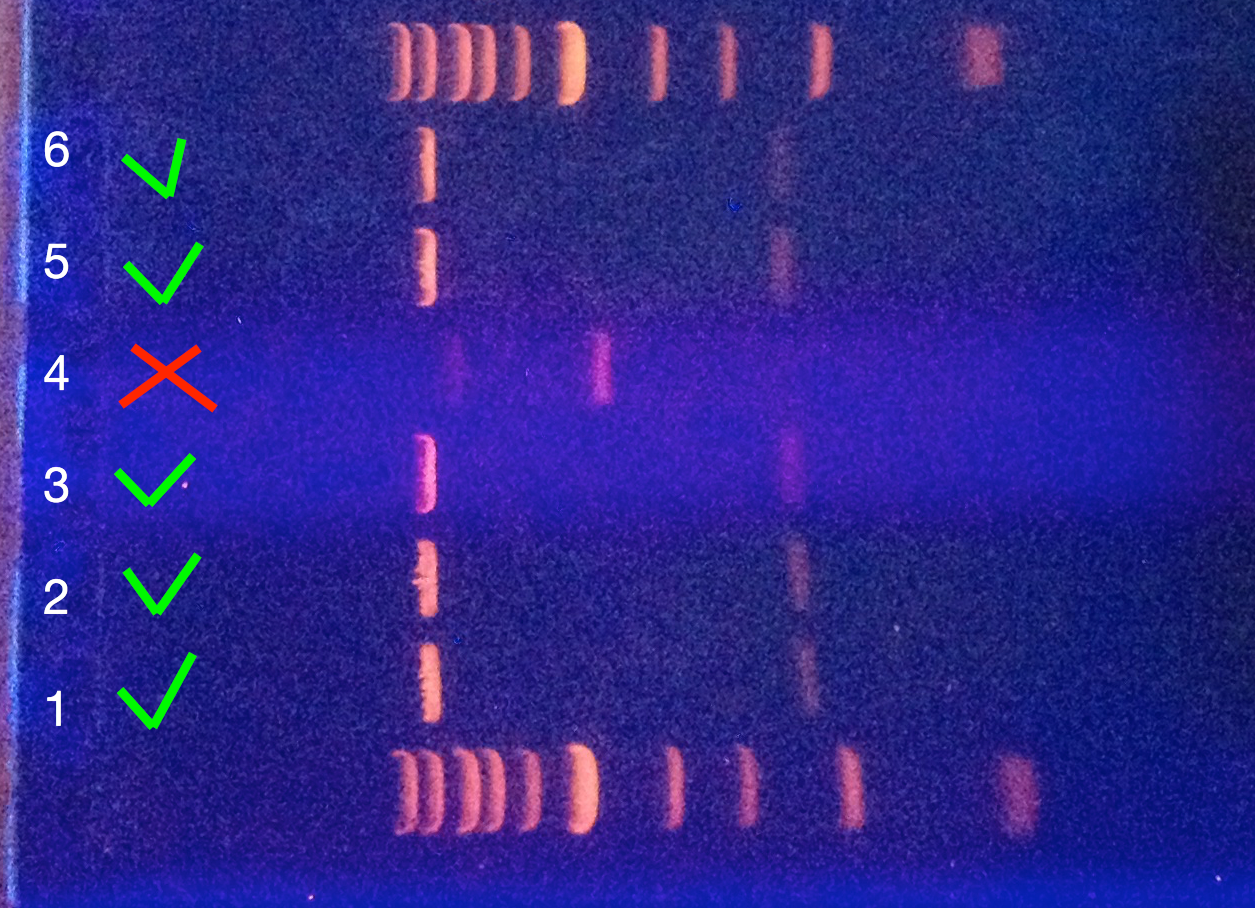
Summary: We successfully assembled synthetic MATx integration plasmid. Sequencing will follow.
Module 2
PCR of the incomplete MF(ALPHA)1 locus (see the Design page for details) from the genome of Saccharomyces cerevisiae 7283 strain (Genome extraction, PCR, Gel electrophoresis).
Band-stab PCR of the amplified incomplete MF(ALPHA)1 locus in order to add the actual pheromone and a stop codon.
Cloning of the obtained pheromone into pRSII416 vector (Restriction digest, Ligation, Transformation).
Verification of the pRSII416_sc_alpha construct (Miniprep, Restriction digest, Gel electrophoresis).
Summary: We successfully obtained mating pheromone from Saccharomyces cerevisiae with its secretion tag and cloned it into pRSII416 vector. We also prepared pCUP1 promoter for the cloning upstream of this pheromone.
Module 3
PCR amplification of the streptavidin gBlock with M13 primers (PCR).
Restriction digest of the PCR product and pCT302 vector. Digested products were gel purified and ligated. Transformation of DH5alpha bacteria cells with ligation product (Restriction digest, Ligation).
Summary: Streptavidin ORF was successfully cloned into yeast display vector pCT302.
Week 3 (18-24)
Module 1
Sequencing of synthetic MATx insert.
Summary: Sequencing confirmed successful assemble of synthetic MATx.
Module 2
PCR amplification of pGAL1 promoter from the genome of Saccharomyces cerevisiae 7284 strain (PCR, Gel electrophoresis).
Cloning of the amplified pCUP1 from Week 2 into pRSII416_sc_alpha plasmid (Restriction digest, Ligation, Transformation).
Verification of the pRSII416_pCUP1_sc_alpha construct (Miniprep, Restriction digest, Gel electrophoresis).
Summary: We have successfully obtained plasmid with a mating pheromone under the control of pCUP1 promoter and prepared pGAL1 promoter for the control of ste2 gene.
Module 3
Miniprep from selected transformed colonies and restriction digest of isolated plasmids (Restriction digest).
Gel verification and sequencing (Gel electrophoresis).
Summary: Transformed colonies had correct vectors. Sequencing data showed us that streptavidin gene is inserted in frame and is without any mutations.
Week 4 (25-31)
Module 1
Extraction of MATa locus from genome of MATa strain in order to obtain precise sequence of MATa locus. PCR of MATa locus for sequencing. Both steps 3x repeated. Gel always showed unsuccessful extraction of MATa strain. (Genome extraction,PCR, Gel electrophoresis)
Summary: We unsuccessfully tried to extract MATa locus from genome.
June
Week 5 (1-07)
Week 6 (08-14)
Week 7 (15-21)
Week 8 (22-28)
Week 9 (29-05)
Module 5
PDMS molding (40μm high silicon masters)
July
Week 10 (06-12)
Week 11 (13-19)
Week 12 (20-26)
Week 13 (27-02)
August
Week 14 (03-09)
Module 3
Transformation of the EBY100 yeast cells with the streptavidin yeast display plasmid (Transformation).
Growing and induction of the yeast transformants in 20 °C and 30 °C. Induction in 20 °C was used because streptavidin monomers tend to fold incorrectly in higher temperatures.
Microfluidics experiments examined functionality of the displayed streptavidin. Microfluidics chips covered with biotinylated gelatin were used in our case.
Summary: Transformed yeast cells were not able to bind to the biotinylated surface. This could be due to a several reasons. Firstly, streptavidin monomers could be folded incorrectly. Secondly, functional streptavdin unit composes of four streptavidin monomers, there is only a little chance that four of the displayed monomers will be in the correct conformational positions to form functional streptavidin unit. Thirdly, there might not be enough of biotin molecules on the microfluidic chips for mediating the cell to chip connection. We also decided that expressing both Aga1 and Aga2 with constitutive promoter could be a better idea, as yeast with plasmids using galactose promoters need to grow in a medium containing sacharose/galactose ergo grow slower.
Week 15 (10-16)
Module 3
Adding of the restriction sites at the end of EpCAM gBlock. One reaction added restriction sites needed for cloning into yeast display plasmid, the other added restriction sites needed for cloning into pRSII plasmid needed for secrection of EpCAM protein (PCR).
Purification of the PCR products and subsequent restriction digest with according restriction enzymes. gBlocks encoding Anti-cMyc scFv, Anti-EpCAM scFv and Anti-HuA scFv were also digested, but only for the use in yeast display plasmids (Restriction digest).
Gel purified inserts were ligated either with the yeast display plasmid (pCT3O2) or the secretion plasmid - only EpCAM ORF (pRSII 416 with inducible CUP1 promoter and pheromone signalling sequence). Ligation products were transformed into DH5alpha bacteria cells (Ligation, Transformation).
Miniprep of transformants and restriction digest testing (Restriction digest).
Summary: We were unable to obtain any usable transformants with the secretion plasmid, however this project was canceled because of more pressing issues. Sequencing data showed that inserts in the yeast display plasmids are in frame and without any mutations.
Week 16 (17-23)
Module 3
PCR of the pTV3 promoter and CYC1 transcription terminator (PCR).
Restricted PCR products were gel purified and ligated. Ligation product was PCR amplified with primers used in the preceding PCR reaction (5' primer for pTV3 promoter, 3' primer for CYC1 transcription factor) (PCR, Restriction digest, Ligation).
PCR product (expression cassette) was restricted for use in pRSII 413 and pRSII 415 plasmids (Restriction digest).
Ligation with given vectors and transformation of DH5aplha bacteria cells (Ligation, Transformation).
Summary: We were not successfull in creating the universal expression vectors (pRSII 413/415 + expression cassette).
Module 5
Bonding of PDMS to glass (6 microfluidic chips encapsulated on two glass slides)
Week 17 (24-30)
Module 3
PCR amplification of the Aga1 gene from the genome and purification of the product (Genome extraction).
Restriction digest of yeast display plasmids(pCT302 Anti-cMyc/Anti-EpCAM/Anti-HuA/EpCAM/Streptavidin) and PCR product encoding Aga1 protein (Restriction digest).
Ligation of expression cassette and pRSII 413/415 plasmids (Ligation).
Transformation of DH5alpha bacteria cells, patches, minipreps and restriction digest testing (Transformation, Restriction digest).
Summary: We were not able to obtain correct expression vectors. However, we were successful at amplification of the Aga1 gene from genome and we also purified constructs encoding Aga2 and Anti-cMyc/Anti-EpCAM/Anti-HuA/EpCAM/Streptavidin fusion genes. Since our expression vector was not ready for cloning, we could not proceed.
Week 18 (31-06)
Module 3
We transformed EBY100 yeast cells with Anti-cMyc, Anti-EpCAM, Anti-HuA and EpCAM inducible yeast display plasmids (Transformation).
Restriction of expression cassette and pRSII 413 and pRSII 415 vectors, subsequent gel purification, ligation and transformation of DH5alpha bacterial cells (Restriction digest, Ligation, Transformation).
Summary: Transformation of EBY100 yeast cells was not successful, no colonies were visible on the solid growing medium. The last attempt of universal expression plasmid (expression cassette on pRSII 413 and pRSII 415 plasmids) construction was not successfull.
Module 5
Signal transmission experiments in microfluidics: MATx + MATa pFUS1-GFP.
September
Week 19 (07-13)
Module 3
PCR amplification of Anti-cMyc, Anti-EpCAM and EpCAM BioBricks from yeast display plasmids (PCR).
Purification of the PCR products, ligation and transformation to DH5alpha bacterial cells (Restriction digest, Ligation, Transformation).
Second attempt of yeast transforamtion with Anti-cMyc, Anti-EpCAM, Anti-HuA and EpCAM inducible yeast display plasmids (Transformation).
Summary: We successfully transformed EBY100 yeast cells with four different types of yeast display plasmid. We also constructed the final BioBrick plasmids.
Module 5
Bonding of PDMS to glass (3 microfluidic chips encapsulated on a glass slide)
Signal transmission experiments in microfluidics: MATx + MATa pFUS1-GFP.
Week 20 (14-20)
